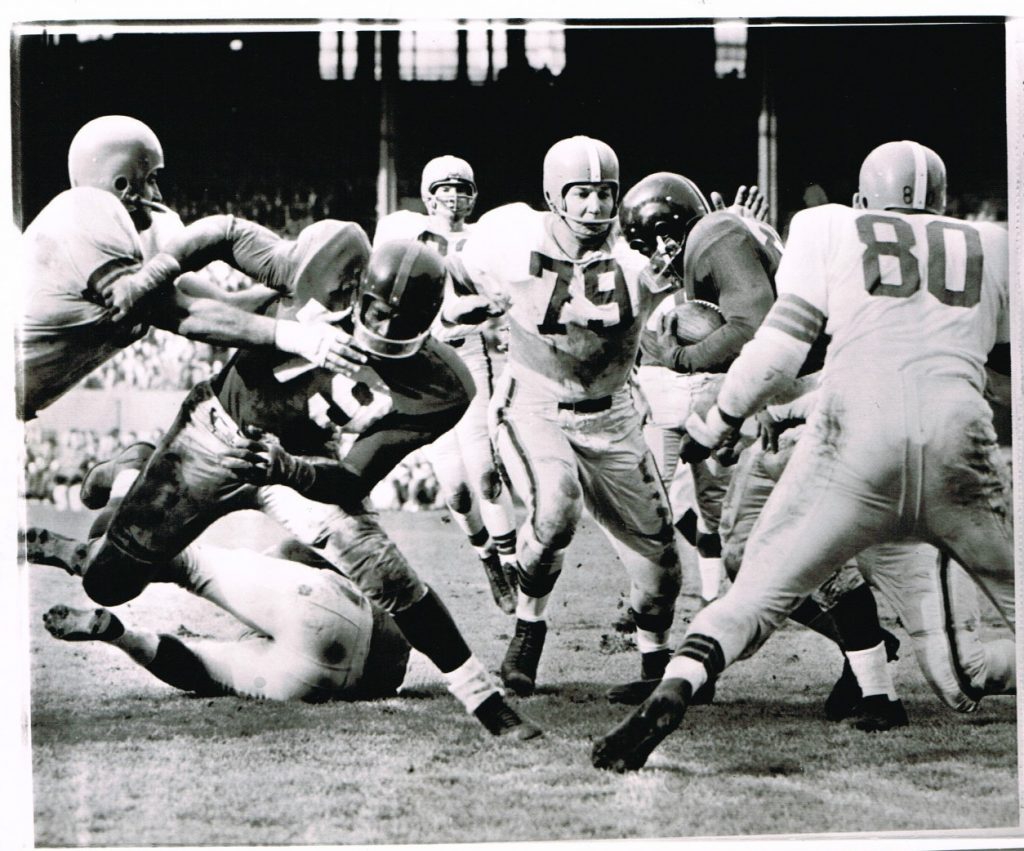
Roosevelt Brown, New York Giants (October 31, 1954)
New York Giants – Cleveland Browns 1950-1959 (Part II)
(Part I)
Innovation via Delegation
The New York Giants first sought Army Black Knight Head Coach Earl “Red” Blaik as the replacement for Owen. After he declined the offer, assistant coach and former end Jim Lee Howell accepted the job, but only on the condition that he would be able to hire a staff consisting of coordinators on both sides of the ball – a unique idea at that time. Howell said, “Before the war, they didn’t specialize in coaches. One coach taught everybody everything.” Yet Howell foresaw a structure where the coordinators would handle their own sides of the ball, studying film, drawing up game plans, and grading their players while he oversaw the operation in more of an administrative role.
Landry had already served in a player-coach role under Owen, which not only would continue but expand. Instead of merely teaching Owen’s concepts to his teammates, Landry, who was regarded as an introspective genius by his peers, would be counted on to conceive his own game plans, a task he relished with aplomb. While playing in the Umbrella, he was already thinking ahead, visualizing a strong line that covered all possible gaps, linebackers who flowed to the point-of-attack, and a defensive backfield that covered zones on the field. Howell said, “Landry was brilliant, very, very smart. He could size up a situation very quickly and get it right.”
Sensing the defense was in good hands, Howell went outside the organization to fix the broken offense. Blaik suggested to the Giants his backfield coach, who badly yearned to coach in the NFL. Vince Lombardi (who went by Vinnie) had been a very successful high school coach at St. Cecilia’s in New Jersey before serving his five-year apprenticeship under Blaik at West Point. Among the things he picked up from one of the nation’s highest-regarded coaches was organization of practices, film study (still a relatively new idea at the time and not widely used), and an emphasis on unit execution rather than deception.
Working from Blaik’s dynamic power T-Formation, Lombardi saw many possibilities, which included implementing Single Wing blocking techniques for the offensive line (i.e. pulling guards) that he had learned while playing at Fordham. Howell liked what he saw in this burgeoning coach, “Lombardi teaches the style of football I like and believe in. Vinnie is daring and he is brainy. He knew what he could do with the players. His was very basic in his thinking. He was just a fine coach.”
The basic tenet of Lombardi’s philosophy was that players need condensed, uncomplicated information. “A few men working closely together in a spirit of discipline, singleness of purpose, and a commitment to excellence could succeed no matter the odds.” This was distilled to perfection with his signature play, the sweep.
Giants had been last in rushing in 1953. That would not be the case in 1954. Gifford teamed with new fullbacks Alex Webster and Mel Triplett. Left tackle Rosey Brown blocked and pulled. And the Giants plowed their way through the eight-man defensive fronts that were predominant of that period. Lombardi’s wider line splits made the defensive middle guard (today referred to as the nose tackle) vulnerable to double-teams.
The concert of destruction that took place at the snap was a choreographed framework that allowed for improvisation in accordance with how the defense reacted. The guards pulled. The lead guard blocked the defensive halfback and the offside guard blocked either the inside or outside linebacker. The center blocked back on defensive tackle. The onside offensive tackle chipped the defensive end, and then sealed the outside linebacker. The fullback or halfback blocked the defensive end, and then led the ball carrier into the hole, while the tight end influence-blocked the defensive end away from the point-of-attack. The reads of the ball carrier and his blocker (a halfback or fullback) was to determine the edge blocking, and the runner would decide whether to cut inside or take play to the edge.
Over time, Gifford would also have the added option of throwing the football. If Gifford made the proper read and a big play was available, he would pull up and loft a pass over rolled up defensive backs.
Lombardi humbly stated of his soon-to-be legendary sweep, “There is nothing spectacular about it. It’s just a yard gainer. It’s my number one play because it requires all eleven men to play as one to make it succeed, and that’s what ‘team’ means.”
The players noticed the differences immediately when they met at camp that summer. Halfback Kyle Rote noted, “When Howell took over in 1954 we started to have separate offensive and defensive meetings. Before, we all met in one big room. But the offense and defense became separate and definitive units under Jim Lee.”
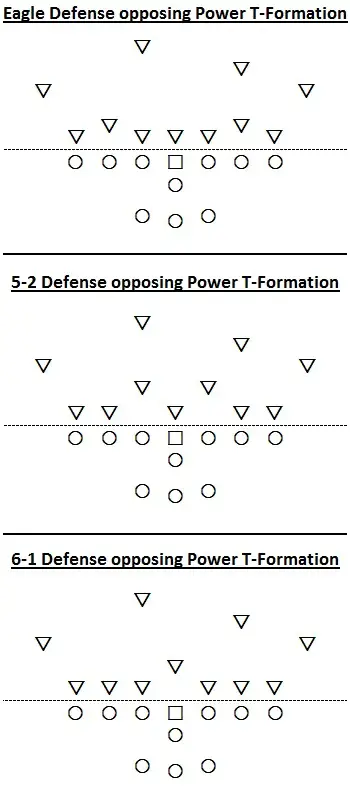 Howell had traveled to Mississippi that off-season and promised Conerly if he came back he would be better protected. To make the existence of his reluctant quarterback more comfortable, the A-Formation was discarded, the T-Formation fully installed, terminology simplified, and a system of automatics that enabled Conerly to change the play at the line was developed.
Howell had traveled to Mississippi that off-season and promised Conerly if he came back he would be better protected. To make the existence of his reluctant quarterback more comfortable, the A-Formation was discarded, the T-Formation fully installed, terminology simplified, and a system of automatics that enabled Conerly to change the play at the line was developed.
Lombardi was also a breath of fresh air to Gifford. At the first practice the coach told the player, “We’re through fooling around with you. You’re a back now.” The stronger line would take time to gel, but players like Brown, Jack Stroud, and Ray Wietecha were soon to become stalwarts in the newly renamed Eastern Conference, and they gave the Giants a new attitude.
Although the Giants’ offensive system was largely ground-based and built around Gifford, the passing game was also vastly improved. End Bob Schnelker was the deep threat while Kyle Rote ran clever patterns underneath. Whether the pass was coming from Conerly or Gifford was the defense’s guess. Lombardi said, “Two intangibles make Gifford great – his versatility and his alertness. He gives the opposition fits by keeping it off balance. If the secondary comes up fast to check his run, he’ll heave the ball downfield; if the defense holds back, Frank’ll keep on running.”
The changes were evident early during the regular season. The Giants started the season 4-0, with point totals of 41, 51, and 31 in impressive wins. Week 6 brought a 24-14 loss at Cleveland, but the Giants bounced back with romps over Philadelphia and Washington.
Disaster struck in back-to-back games at the Polo Grounds at the end of November. Gifford injured his knee during a 17-16 loss to the Rams, and Conerly injured his knee on the first play of the rematch with Cleveland, which the Giants lost 17-6. The Browns went on to defeat Detroit for the NFL title.
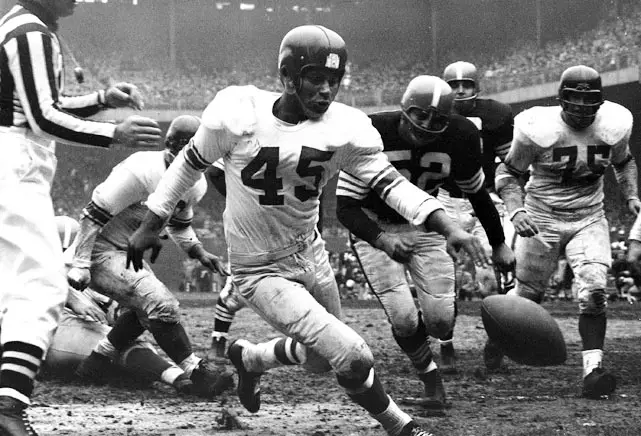
Emlen Tunnell (45), New York Giants (November 28, 1954)
Despite the third-place finish, the Giants carried optimism into the offseason. Lombardi’s sweep proved to be a success – Gifford’s 5.6 yards per carry led the Eastern Conference. The passing game’s efficiency improved exponentially – in 1953 the Giants’ ends caught a total of three touchdown passes; in 1954 they scored 20. There was a feeling of improvement, accomplishment, and a belief in the new systems being taught by the staff.
Motley left the Browns after the season, but Cleveland made it six consecutive conference titles in 1955 regardless. The Giants started the season slowly and sputtered to a 2-5 record after a physically-tough loss at Cleveland. But they would not lose again. The highlight of their 6-5-1 season was a 35-35 tie with the Browns in the final Giants’ football game at the Polo Grounds (although nobody knew that at the time).
This game marked the first time Howell started Don Heinrich at quarterback, ostensibly to allow Conerly to “spot flaws in the Browns from the bench.” Not all Giants players liked this sometimes controversial strategy, including the supposed number one quarterback himself. Conerly said years later, “You can’t see a damn thing from the bench. It’s the worst seat in the place. I don’t know why they did that.”
The crowd of 49,699 for the game billed as the “grudge match” was the largest in New York that year. Two future NFL head coaches started for Cleveland at linebacker: Walt Michaels and Chuck Noll. The running game by committee for the Browns was Curley Morrison and Ed Modzelewski (whose brother Dick would join the Giants in 1956). On occasion, Brown would deploy five wide receiver sets to confound Landry’s growingly versatile 6-1-4 defense.
The early advantage in the coaching chess game went to Howell as Heinrich staked New York to an early 14-0 lead. However, Graham calmly led his team back and Cleveland took the lead 21-14 late in the third quarter. The Giants, now led by Conerly, immediately tied the game 21-21 on a disputed play. Price was seemingly on his way to a 20-yard touchdown run, but was hit and fumbled at the goal line. New York’s Bob Schnelker came out of the fracas with the ball. When the Giants were awarded a touchdown, the Cleveland bench erupted in protest.
The Giants’ defensive front harassed Graham on the ensuing possession, and forced a Cleveland punt. Conerly engineered a 65-yard drive that he capped off with a 16-yard touchdown pass to Rote in the back of the end zone. Graham responded with a precision drive of his own, tying the game 28-28. Noll gave the Browns the lead when he intercepted a Conerly pass and returned it 14 yards for the score. The Giants took over on their own 15-yard line, and Conerly drove the Giants 85 yards for the touchdown, converting several third downs along the way. The decisive play was a pass completion to Gifford at the Cleveland 15, where he broke a tackle and raced into the end zone for the 23-yard score. Ben Agajanian’s point after knotted the game 35-35.
Graham was the original master of the yet-to-be-named two-minute drill. All opposing defenses and coaches feared his prowess when there was little time left on the clock. He rarely made a bad read, extended plays with his feet, and would run for yardage when necessary. The three minutes left on the clock probably felt like an eternity to player-coach Landry after the kickoff.
Graham opened the proceedings on his own 27-yard line with a bootleg to the New York 45. Just like that, the Browns were nearing the edge of Groza’s field goal range. Two Morrison rushes pushed the ball down to the Giants’ 19-yard line, and Modzelewski plunged to the 14. Groza came on for a 21-yard attempt with 0:25 on the clock, but Phil Knight leapt high from the line and blocked the kick. New York recovered the loose ball while the Polo Grounds crowd rocked in bedlam. Conerly had time left for one desperation pass, which was completed to the middle of the field as time expired. Regardless, the New York fans gave the Giants a standing ovation as they exited the Polo Grounds. Cleveland went on to their sixth consecutive championship game appearance after the season, and sent Graham off to retirement with a 38-14 win over Sid Gillman’s Los Angeles Rams.
Coordination and the Man in the Middle
Significant changes took place for both teams prior to the 1956 season. Brown was frustrated with finding a suitable signal caller for his offense and rotated Tommy O’Connell, George Ratterman, and Babe Parilli under center. The Giants, on the other hand, found a quarterback for their defense. Landry retired as a player and was now a full-time, fedora-wearing coach on the sideline. As a player, Landry knew his own physical limitations, so he had dedicated himself to being the smarter player. He was always aware not only of his own responsibilities on the field but also those of his teammates. In the burgeoning days of Owen’s Umbrella, while Landry coordinated the secondary, he envisioned all 11 players operating in a similar fashion. As he grew into the responsibilities of coaching, Landry began to teach his teammates the concept of reading offensive tendencies, which he called “keys” during film study.
Landry’s central theory was that an offense’s possibilities were limited once its personnel were on the field and a pre-snap formation was aligned. Post-snap, the defense would then read each offensive player’s first step to see where the play would go. Landry distilled it down to a science. For example, the weight a guard had on his front hand could predict whether he was going to drive block or pull on a run, or drop back to protect on a pass. Landry wanted a smart player like himself to realize the defense’s potential.
Sam Huff came to camp as a guard, but was converted to middle linebacker, a new position that evolved from watching film of Bill Willis on the Browns. On some occasions, Willis would be a half-yard back from the line of scrimmage, either in a three-point or two-point stance. But Landry used Huff as a fully declared linebacker, a full yard back from the center, always in a two-point stance, which allowed him to read the offensive backfield. Landry said, “Sam was a very disciplined player. The thing that made him so good was that he would listen, and he would do what was necessary to operate our defense. The effectiveness of the 4-3 depends on the defensive team recognizing a formation, knowing what plays can be run from that formation, and then recognizing keys that tell them the likely play or plays to expect.” Huff attributed the success to his teammates, “We played as a team on that Giants’ squad. I had help. The defense was set up so the defensive linemen actually kept the blockers off me.”
When the two 1-1 teams met in Week 3 at Cleveland, the strain of lacking an on-field leader had already worn on Brown. Always way ahead of his time, he conceived of radio communication between himself and the quarterback to get the plays called. The Giants were onto him early, and designated rookie end Bob Topp to sit on the end of the bench and decipher the Browns’ plays with a receiver tuned in to Cleveland’s frequency. Brown eventually reverted to his rotating guard system to send the calls in, but the Giants rolled to their first win over the Browns in three years, 21-9, behind the strength of a rushing attack that compiled 256 yards. On Monday, The New York Times declared “the Giants handled the Browns the in the manner the Browns used to handle the Giants.” On Tuesday,NFL Commissioner Bell barred electronic coaching devices on game day.
The Giants flexed their muscles with four more wins over Eastern Conference opponents, three of which took place on their new home field at venerable Yankee Stadium, just across the Macomb Dam Bridge from the Polo Grounds. When the Giants and Browns met in Week 11 for their rematch, 4-6 Cleveland was in the unfamiliar position of looking up in the standings at 7-2-1 New York. Brown must have used that as motivation, as the Browns defied expectations and manhandled the Giants in the rain and snow on the muddy field in a 24-7 romp.
The Giants clinched the Eastern Conference the following week with a win at Philadelphia, then won their first NFL Title since 1938 when they defeated the Chicago Bears at Yankee Stadium 47-7. Gifford had a season for the ages. He led team in both rushing yards and pass receptions, for the first of four consecutive seasons, and led the NFL with 1,422 total yards from scrimmage (819 rushing, 603 receiving). Gifford scored nine total touchdowns, five rushing and four receiving, and added two more scoring passes from his option role on the sweep. He also had 161 total yards and a touchdown in the championship game against the Bears. His receiving the NFL MVP award was almost anti-climactic.
The Browns made good use of their draft position following their first losing season in team history, taking fullback Jim Brown from Syracuse. The quarterback situation was still somewhat unsettled, as Brown split starts between O’Connell and Milt Plum, but the effects were minimal as their greatest success came when they were handing off to Brown, who led the NFL as a rookie with 942 yards and nine touchdowns. Brown would lead the NFL in rushing eight of his nine seasons, and this was the only one in which he did not go over 1,000 yards. He would also grow into a receiving threat over time, and lead the NFL in total yards from scrimmage six times.
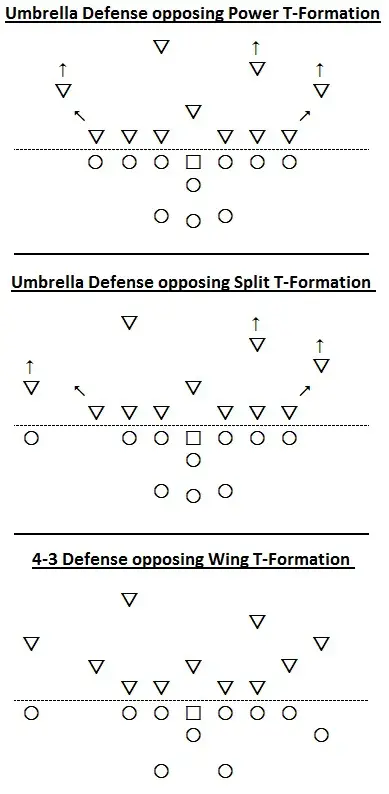 The Giants opened the season at Cleveland in what would be a tense defensive battle. Brown rushed for 89 yards on 21 carries, but neither team accumulated 200 total yards of offense. Cleveland won on a Groza kick at 0:23, 6-3. The Giants rebounded to win seven of their next eight games, fueled in part by another Landry defensive innovation: a linebacker “red dog” in which at the snap of the ball, Huff or one of the outside linebackers would immediately attack the backfield.
The Giants opened the season at Cleveland in what would be a tense defensive battle. Brown rushed for 89 yards on 21 carries, but neither team accumulated 200 total yards of offense. Cleveland won on a Groza kick at 0:23, 6-3. The Giants rebounded to win seven of their next eight games, fueled in part by another Landry defensive innovation: a linebacker “red dog” in which at the snap of the ball, Huff or one of the outside linebackers would immediately attack the backfield.
When the calendar turned to December, the 7-2 Giants were just a half game behind the 7-1-1 Browns. New York dropped games against San Francisco and Pittsburgh, rendering the finale against Cleveland meaningless in regards to the Eastern Conference standings. However, the Giants-Browns rivalry had achieved Yankees-Red Sox status, and the advance ticket sales for the game were 50,000 and the turnstile count for the game was 54,292, the Giants’ largest home crowd for the season.
This was the first game where Landry assigned Huff the explicit responsibility of keying solely on Brown. Landry said, “Our defense was not designed specifically for Sam Huff to stop Jim Brown, our defense was designed to stop the offense we were working against. Our defense was based on coordination. Sam was just one of the 11 people who were coordinated. Specifically, the front seven was coordinated against the run. He was just one element in that group. But he got great recognition, which he deserved, because in this particular defense he was stopping Jim Brown, who is almost unstoppable. ” Huff versus Brown almost became a rivalry within a rivalry.
The Giants’ offense played well. Heinrich and Conerly combined for 282 passing yards and Gifford scored two touchdowns, one rushing and one receiving. New York led 28-27 with under 7:00 left on the clock, but Plum lead Cleveland to the winning score as Graham had done so many times before. Brown had another strong outing for Cleveland, rushing for 78 yards, including a 20-yard touchdown in the 34-28 victory. Cleveland returned to the championship game but lost again to Detroit.
Reckoning and Recognition
The Football Giants’ ascension in New York’s consciousness came at just the right time. Following the 1957 season, both the Baseball Giants and Brooklyn Dodgers left town for California. Yankee Stadium was the fulcrum of professional sports in New York for all of 1958.
The first meeting between the two Eastern Conference stalwarts did not take place until the first week of November when the 5-0 Browns hosted the 3-2 Giants. A raucous crowd of 78,404, the fourth largest in Cleveland professional football history to-date, packed Cleveland Stadium but went home disappointed after a second-half come-from-behind effort by New York.
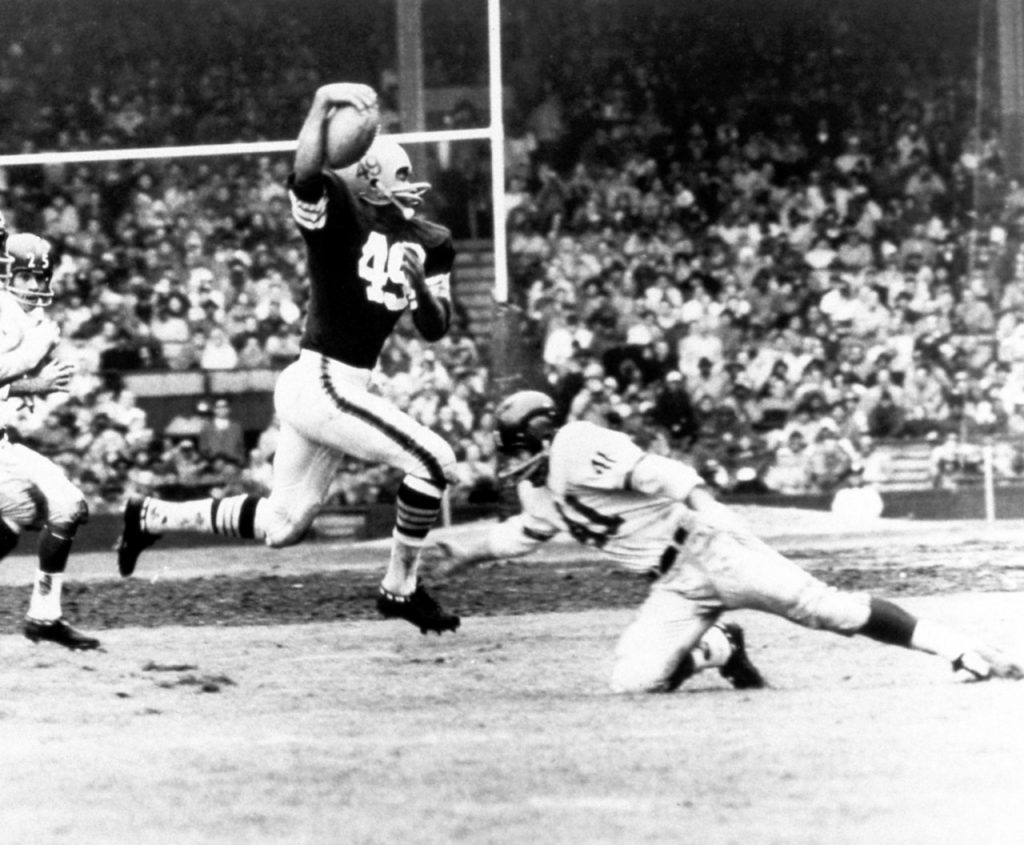
New York Giants at Cleveland Browns (November 2, 1958)
Brown looked unstoppable for Cleveland in the first half, rushing for a 58-yard touchdown (his 15th of the season in just his sixth game!) but the aerial game struggled. Plum completed only four passes for the entire game and was intercepted twice by Jimmy Patton.
The Giants’ attack was balanced. Conerly tossed three scoring passes, two to Webster in the second half, the last of which came with less than three minutes remaining. They brought Conerly’s career touchdown pass total to 140, which placed him second all-time behind Sammy Baugh’s 187. The unlikely hero was Triplett, who outrushed Brown on the day 116 yards to 113 (which was 50 yards below Brown’s season average). It would be the sole 100-yard effort in Triplett’s career.
Landry’s coordinated defense truly came into its own in the second half. He had noticed keys on Cleveland’s formations that tipped off when Brown was getting the ball, and when he was being used as a decoy and the ball would go instead to Bobby Mitchell. Huff’s reads of Brown were nearly flawless, as Cleveland had only 23 plays from scrimmage in the second half, gained only two first downs, and never crossed the 50-yard line. Cleveland’s 17 points were far below the 35 they had averaged over their first five games.
The defense-first trend continued for the Giants throughout the season. The 1958 Giants would end up being the lowest-scoring team of Howell’s tenure with 20.5 points per game. But the New York fans not only didn’t mind this brand of football, they relished it. Landry recalled, “We knew we were something special in New York. The city was just on fire. It was amazing the way they supported the Giants, and the defense. This was a brand new thing in pro football, because no one even knew when you played defense until the late fifties.”
Cleveland and New York met for the final game of the regular season at Yankee Stadium with the Eastern Conference crown on the line. The 9-2 Browns stunned the 63,192 in attendance on the first play from scrimmage. Brown galloped through the middle of the Giants’ 4-3 front untouched and outran the secondary for a 65-yard touchdown. It was all defense for the remainder of the half as Pat Summerall and Groza exchanged field goals for the 10-3 halftime score. The Summerall field goal came after an uncharacteristic Cleveland fumble, which was recovered by Jim Katkavage on Cleveland’s 39-yard line.
As the snow fell during the scoreless third quarter, the Browns’ confidence increased. Their opening possession of the third quarter took a full 12 minutes off the clock, but the drive ended without points as the Giants thwarted a fake field goal attempt. Conerly’s unit was unable to move the ball and punted as the period came to a close. The big play to start the game loomed as the possible difference in a trip to the NFL Championship. This game took on the feel of a stare-down between two rugged defensive outfits.
Early in the fourth quarter the unthinkable happened as Cleveland turned the ball over in their own territory a second time. Poise and precision had always been hallmarks of Paul Brown’s team, which had committed just 12 turnovers in their first 11 games. Plum fumbled on his own 47-yard line and Andy Robustelli recovered for New York at the 45. Stymied by Cleveland’s defense all day, Lombardi’s unit seized the sudden change in momentum and struck quickly on his signature sweep/option. On first down, Conerly faked to Webster and handed off to Gifford who ran toward the right sideline. As he neared the boundary, Gifford spotted Rote coming open behind the defense. He pulled up and lofted a deep pass for a 39-yard advance to the Browns’ six-yard line. After a rush for a loss and incomplete pass by Conerly, Gifford completed a touchdown pass to Schnelker between two defenders on another sweep/option to tie the game 10-10 with just over 10 minutes to play.
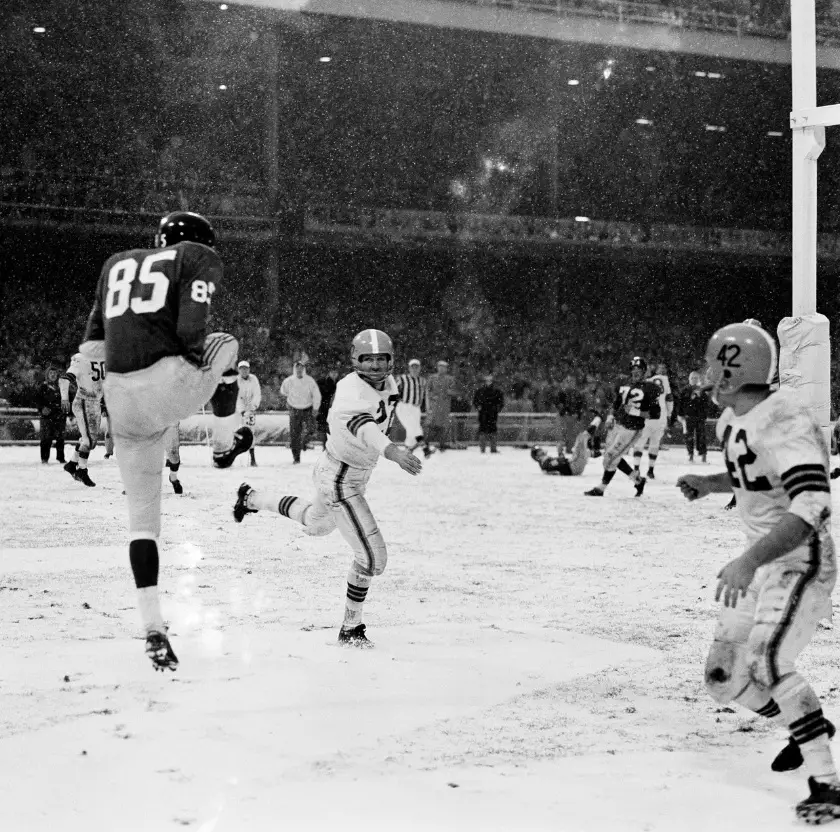
Bob Schnelker (85), New York Giants (December 14, 1958)
The Giants’ defense forced a punt after two sacks of Plum by Rosey Grier. But the offense failed to capitalize despite favorable field position when Summerall’s 33-yard field goal attempt sailed wide left. The kicker remembered, “I’d have liked to have gone anywhere but back to the bench. But four or five of the guys came over and told me to forget it, that they’d get me another chance.”
Summerall did get another chance. The New York defense forced another three-and-out. The Giants fielded a short punt near mid-field (the exact yard line was impossible to determine on the now snow-covered field). Three incomplete passes left the Giants’ last hope hanging in the balance on fourth down and 2:07 on the clock, with a tie as good as a victory for Cleveland. Confidence was lacking for a Giants’ offense that had struggled all day. On third down they had missed a sure touchdown connection between Conerly (who was only 10-for-27 on the day) and Webster. “I had (the defender) beat pretty good, five or six yards. But the ball came out of the snow – I know that’s no excuse – and it went right through my hands and I dropped it on the five-yard line.” Webster said, “It would have been an easy six points.”
Howell took the unusual step of overruling his offensive coordinator Lombardi, who wanted to call another pass play, and sent Summerall on to the field for a desperation kick attempt. Summerall said, “I couldn’t believe that Jim Lee was asking me to that. That was the longest attempt I’d ever made for the Giants. It was a bad field and it was so unrealistic. Most of the fellows on the bench couldn’t believe it either.” Wellington Mara shared the popular belief, “That Summerall kick was the most vivid play I remember. I was (up in the press box) sitting next to Ken Kavanaugh and Walt Yowarsky and we all said, ‘He can’t kick it that far. What are we doing?’”
The attempt was logged officially from 49 yards, but some believe it was further. Summerall said, “No one knows how far it had to go. You couldn’t see the yard markers. The snow had obliterated them. But it was more than 50 I’ll tell you that.” Rote supported that theory. He remembered standing on the 50-yard line and said that Conerly spotted the ball, “two yards past me.”
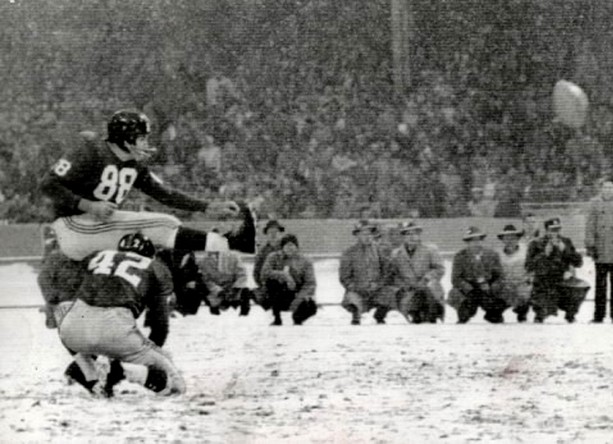
Pat Summerall (88) and Charlie Conerly (42), New York Giants (December 14, 1958)
Regardless of the actual distance, any kick on that snow-covered field in the wind was going to be a formidable task. As Conerly cleared a spot for the placement, he heard Cleveland players shouting “stay onsides!” to one another. The snap, spot, and hold were perfect as could be, but the ball’s trajectory was not.
Summerall described the kick’s near wayward flight, “I knew as soon as I touched it that it was going to be far enough. My only thought was that sometime you hit a ball too close to the center and it behaves like a knuckleball, breaking from side to side. It was weaving out. But when it got to the 10 I could see it breaking back to the inside.” Conerly felt a little better about it, “I looked up as soon as Pat hit the ball. It looked real good and it made me feel real good. There was a lot of guilt riding on that one.”
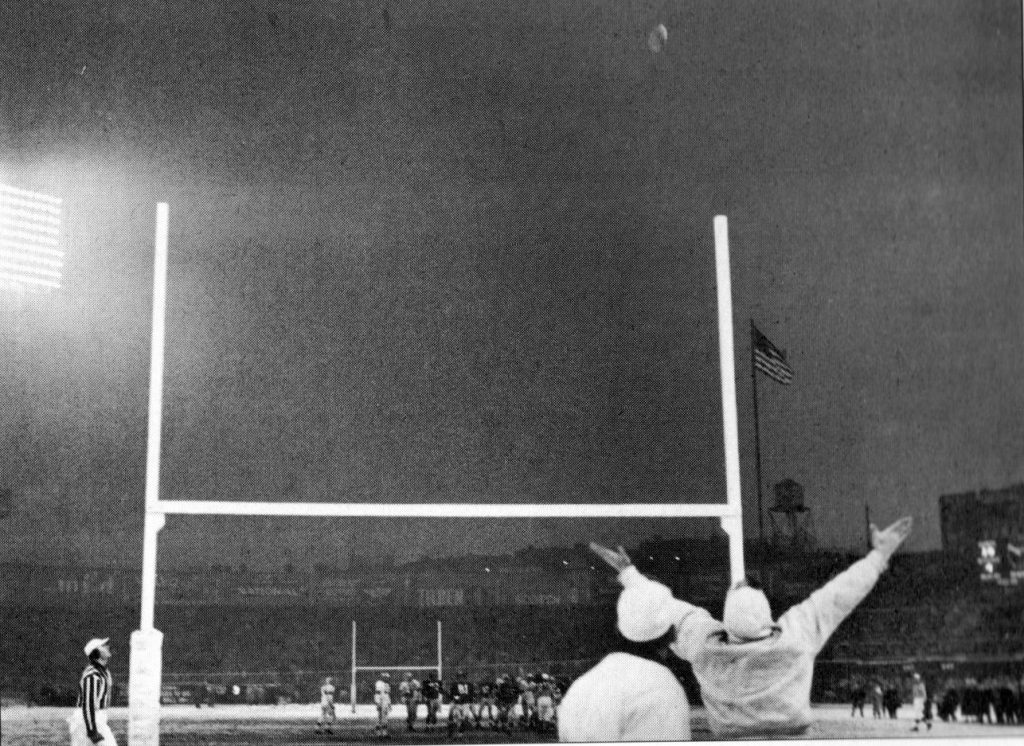
Pat Summerall’s Field Goal is Good, Cleveland Browns at New York Giants (December 14, 1958)
Summerall was mobbed by teammates as Yankee Stadium erupted in delirium. Plum moved Cleveland near mid-field where Summerall’s counterpart Groza attempted what was thought to be a 55-yard field goal, but it fell well short of the cross bar. The Giants survived 13-10 and had forced a playoff for the right to face the Baltimore Colts for the NFL Championship.
The perfectionist Paul Brown blamed himself for the loss. He stayed up that night and re-watched the game film. He concluded he made a tactical error by running the ball too much, perhaps caused by overconfidence from the game’s first play. After that 65-yard touchdown run, Brown was held to just 83 yards on 25 carries.
Brown was not the only one looking back; history was not on the Giants’ side. The Giants were 0-2 in the franchise’s two previous standings tie-breakers. The 1950 loss at Cleveland lingered in recent memory, but another from the past resonated as well. After the 1943 season, New York was tied atop the Eastern Division with Washington 6-3-1. The Giants forced the playoff by defeating the Redskins not only once, but twice, to close the season. However, despite the playoff being held within the friendly confines of the Polo Grounds, Sammy Baugh and his teammates exacted thorough revenge by whipping the Giants 28-0. Defeating the same team three times in the same season was believed to be an unrealistic expectation by most observers.
The players did not seem to notice the doubters however. Practices at Yankee Stadium were unusually spirited throughout the week, crisp and hard-hitting. The enthusiasm carried over to the game on a bright but bitterly cold 20-degree Sunday in front of 62,742 eager fans.
Jim Brown received the opening kickoff and advanced it 45 yards. Plum completed a pass before Brown fumbled on a hit by Katkavage that was recovered by Grier. Heinrich returned the favor however and threw an interception of his own. After a Cleveland punt, Heinrich threw a second interception. The New York defense held again. And Conerly took the field and crafted a 12-play, 84-yard drive, mixing runs and passes. The final play of the drive was a bit of razzle-dazzle drawn up by Lombardi earlier that week.
The play started out as a simple sweep left by Webster on the Cleveland 18-yard line. Webster then handed off to a reversing Gifford sprinting right. Gifford cut through a hole behind the right guard. Racing up field, Gifford juked a safety then surprised everybody when he lateralled to a trailing Conerly. The old quarterback was hit at the goal line but fell into the end zone for what would be the game’s lone touchdown. Conerly said, “It was something new we put in this week. The lateral on the end was optional.”
The Browns responded with another drive into Giants’ territory, but Groza’s 46-yard field goal attempt was wide left and short. Conerly engineered another drive that Summerall capped with a three-pointer to give the Giants a 10-0 lead at the half. Cleveland managed one more scoring threat late in the third quarter when Don Maynard lost a fumble returning a punt. Plum moved the Browns to the New York six-yard line, but following two sacks, Huff intercepted a pass on the first play of the fourth quarter. Cleveland never threatened again. After a quick exchange of punts the Giants ground away the clock with their power running game and controlled the ball 10 of the final 11 minutes.
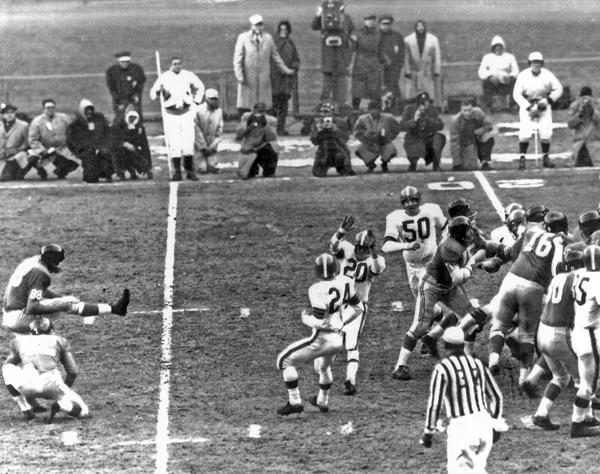
Pat Summerall (88), New York Giants, Eastern Division Playoff (December 21, 1958)
The furiously-fought game’s stars were the magnificent front four, who wrecked Cleveland’s blocking schemes. Robustelli, Katkavage, Grier, and Modzelewski kept Huff free from interference and harassed Plum and Jim Ninowski every single snap. Brown endured the worst showing of his otherwise sterling career with eight yards on seven rushes. Taking into account Brown’s 20-yard run in the third quarter, it means Brown lost 12 yards on his other six carries! Huff said, “Cleveland likes to run its plays to perfection. As long as they run the play perfect, they figure your mistakes will beat you. Well, here I was knowing Jimmy would run and just where he would run. I wasn’t about to make any mistakes.”
The fans in attendance helped fuel the inspired front four’s engine, roaring their appreciation every time the defense held and the Cleveland offense trudged to the sideline. Brown said, “They just played even harder than last week, more determined.” Cleveland was held to a meager 86 yards of offense and seven first downs. The Giants had two times as many plays from scrimmage, 80 to 40, and they controlled the pace with 211 yards on 53 rushes. This was only the second time the Browns were held scoreless in nine NFL seasons, and it was the first in 114 games. The last occurrence was the very first meeting between the two teams in 1950. Howell acknowledged the impressive performance, “They played the best defensive ball I ever saw a club play against a real good team.” Katkavage succinctly stated, “We just played better under pressure.”
The Giants hosted the Baltimore Colts the following week in what became known as “The Greatest Game Ever Played.” Giants’ fans would probably disagree as their team lost the first overtime game in NFL history, 23-17. But the stage had been set for professional football to capture the nation’s imagination. After the season, Lombardi moved on to Green Bay. The Giants repeated as Eastern Conference champions in 1959, this time on the arm of NFL MVP Charlie Conerly who blossomed under the tutelage of new offensive coordinator Allie Sherman. The clinching-game was on a Yankee Stadium field flooded by delirious fans who were probably somewhat in disbelief of the one-sided 48-7 score over Brown’s Cleveland team.
By the end of the next decade, football not only surpassed baseball as the National Pastime, it had become a national obsession, dominating television ratings in season while commanding headlines throughout the offseason. This was a far cry from the game’s humble stature at the opening of the decade when NFL box scores were fortunate to receive a few paragraphs of type while being buried on the sports pages alongside the previous day’s finishers in the money at the local race track.
The two teams represented the American / Eastern Conference in all 10 NFL Title games in the 1950’s, with the Browns winning three (’50, ’54 & ’55) and the Giants one (‘56.) Each franchise is well represented from the era at the Pro Football Hall of Fame.
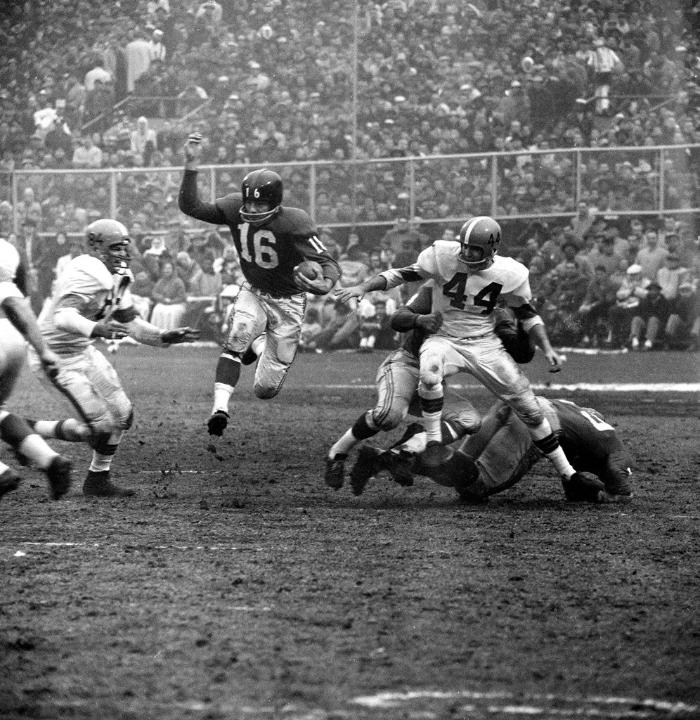
Frank Gifford (16), New York Giants (December 6, 1959)
Cleveland: Paul Brown, Otto Graham, Marion Motley, Bill Willis, Dante Lavelli, Len Ford, Frank Gatski, Lou Groza, Doug Atkins, Mike McCormack, Jim Brown, Henry Jordan, Willie Davis, Gene Hickerson, Bobby Mitchell
New York: Steve Owen, Emlen Tunnell, Arnie Weinmeister, Tom Landry, Frank Gifford, Roosevelt Brown, Vince Lombardi, Andy Robustelli, Sam Huff
The head-to-head outcomes were remarkably even, with Cleveland holding a 10-9-1 regular-season advantage, and both teams winning a conference tie-breaker.
New York Giants vs. Cleveland Browns (1950's)
| 10/1/50 | New York 6 at Cleveland 0 |
| 10/22/50 | New York 17 vs Cleveland 13 |
| 12/17/50 | New York 3 at Cleveland 8 (American Conference Playoff) |
| 10/28/51 | New York 13 at Cleveland 14 |
| 11/18/51 | New York 0 vs Cleveland 10 |
| 10/12/52 | New York 17 at Cleveland 9 |
| 12/14/52 | New York 37 vs Cleveland 34 |
| 10/25/53 | New York 0 vs Cleveland 7 |
| 12/6/53 | New York 14 at Cleveland 62 |
| 10/31/54 | New York 14 at Cleveland 24 |
| 11/28/54 | New York 7 vs Cleveland 16 |
| 11/6/55 | New York 14 at Cleveland 24 |
| 11/27/55 | New York 35 vs Cleveland 35 |
| 10/14/56 | New York 21 at Cleveland 9 |
| 12/9/56 | New York 7 vs Cleveland 24 |
| 9/29/57 | New York 3 at Cleveland 6 |
| 12/15/57 | New York 28 vs Cleveland 34 |
| 11/2/58 | New York 21 at Cleveland 17 |
| 12/14/58 | New York 13 vs Cleveland 10 |
| 12/21/58 | New York 10 vs Cleveland 0 (Eastern Conference Playoff) |
| 10/11/59 | New York 10 at Cleveland 6 |
| 12/6/59 | New York 48 vs Cleveland 7 |


Sorry, the comment form is closed at this time.